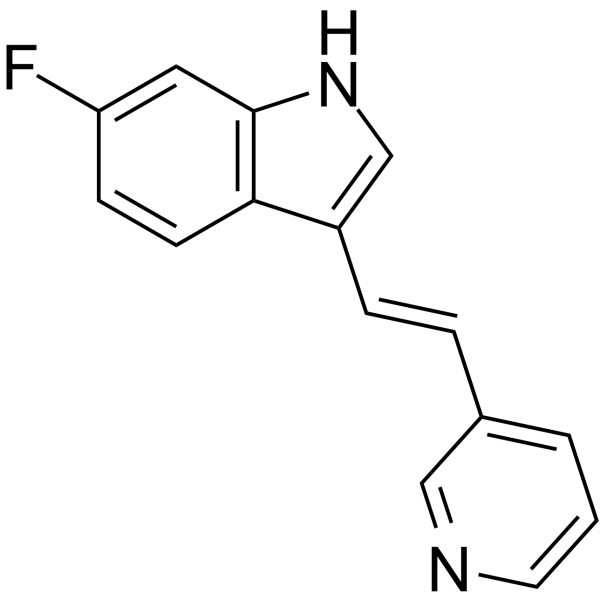680C91

680C91 structure
|
Common Name | 680C91 | ||
|---|---|---|---|---|
| CAS Number | 163239-22-3 | Molecular Weight | 238.26000 | |
| Density | N/A | Boiling Point | N/A | |
| Molecular Formula | C15H11FN2 | Melting Point | N/A | |
| MSDS | Chinese USA | Flash Point | N/A | |
| Symbol |

GHS05 |
Signal Word | Danger | |
Use of 680C91680C91 is an orally active, selective tryptophan 2,3-dioxygenase (TDO) inhibitor with a Ki of 51 nM. TDO is the key enzyme of tryptophan catabolism. 680C91 can be used for the research of cancer immunotherapy and Alzheimer’s Disease[1][2][3][4]. |
| Name | 6-Fluoro-3-[(E)-2-(3-pyridinyl)vinyl]-1H-indole |
|---|---|
| Synonym | More Synonyms |
| Description | 680C91 is an orally active, selective tryptophan 2,3-dioxygenase (TDO) inhibitor with a Ki of 51 nM. TDO is the key enzyme of tryptophan catabolism. 680C91 can be used for the research of cancer immunotherapy and Alzheimer’s Disease[1][2][3][4]. |
|---|---|
| Related Catalog | |
| In Vitro | 680C91 is a potent (Ki=51 nM) and selective TDO inhibitor with no inhibitory activity against indoleamine 2,3-dioxygenase, monoamine oxidase A and B, 5-HT uptake and 5-HT1A,1D,2A and 2C receptors at a concentration of 10 μM[2]. 680C91 inhibits the catabolism of tryptophan by rat liver cells and rat liver perfused in situ[2]. Tdo2 could regulate cell proliferation and stimulate the expression of decidual marker Dtprp in the uterine stromal cells and decidual cells. Tdo2 inhibitor 680C91 also inhibits the prolifer ation activity of uterine decidual cells at 24 h[3]. Treatment of leiomyoma smooth muscle cell (LSMC) and myometrial smooth muscle cell (MSMC) spheroids with 680C91 (25 and 50 μM) significantly represses the expression of collagen type I (COL1A1) and type III (COL3A1) in a dose-dependent manner[4]. Cell Proliferation Assay[3] Cell Line: Uterine stromal cells Concentration: 0.01, 0.05, 0.1, 0.5, 1, 5, and 10 μM Incubation Time: 24 hours Result: The proliferation activity of stromal cells was significantly decreased at 5 and 10 μM. Western Blot Analysis[4] Cell Line: MSMC and LSMC Concentration: 25 and 50 μM Incubation Time: 48 hours Result: Significantly reduced the expression of COL1A1 and COL3A1 in LSMC spheroids with no significant effect on expression of these proteins in MSMC spheroids. |
| In Vivo | 680C91 (a dose of 15 mg/kg for acute treatment ) elevates tryptophan in brain[5]. Animal Model: Male C57Bl6/NCrl mice aged 13-18 weeks[5] Dosage: 15 mg/kg Administration: Administered per os Result: Caused a significant increase in brain tryptophan. |
| References |
| Molecular Formula | C15H11FN2 |
|---|---|
| Molecular Weight | 238.26000 |
| Exact Mass | 238.09100 |
| PSA | 28.68000 |
| LogP | 3.87240 |
| Symbol |

GHS05 |
|---|---|
| Signal Word | Danger |
| Hazard Statements | H318 |
| Precautionary Statements | P280-P305 + P351 + P338 |
| Hazard Codes | C |
| RIDADR | NONH for all modes of transport |
|
A TDO2-AhR signaling axis facilitates anoikis resistance and metastasis in triple-negative breast cancer.
Cancer Res. 75 , 4651-64, (2015) The ability of a cancer cell to develop resistance to anoikis, a programmed cell death process triggered by substratum detachment, is a critical step in the metastatic cascade. Triple-negative breast ... |
|
|
L-kynurenine/aryl hydrocarbon receptor pathway mediates brain damage after experimental stroke.
Circulation 130(23) , 2040-51, (2014) Aryl hydrocarbon receptor (AhR) is a transcription factor that belongs to the basic helix-loop-helix PAS (Per-Arnt-Sim homology domain) family known to mediate the toxic and carcinogenic effects of xe... |
|
|
Tryptophan-2,3-dioxygenase (TDO) inhibition ameliorates neurodegeneration by modulation of kynurenine pathway metabolites.
.PubMed ID Metabolites of the kynurenine pathway (KP) of tryptophan (TRP) degradation have been closely linked to the pathogenesis of several neurodegenerative disorders. Recent work has highlighted the therapeu... |
| PSB 0777 ammonium salt |